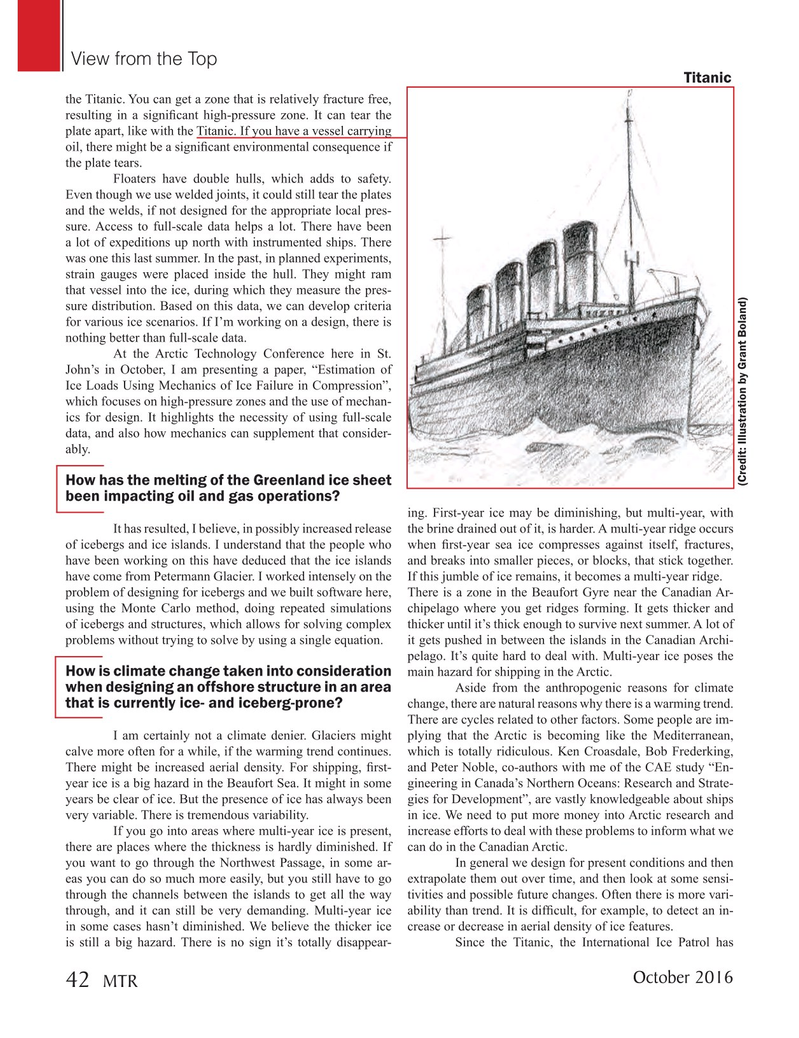
Page 42: of Marine Technology Magazine (October 2016)
AUV Operations
Read this page in Pdf, Flash or Html5 edition of October 2016 Marine Technology Magazine
View from the Top
Titanic the Titanic. You can get a zone that is relatively fracture free, resulting in a signi? cant high-pressure zone. It can tear the plate apart, like with the Titanic. If you have a vessel carrying oil, there might be a signi? cant environmental consequence if the plate tears. Floaters have double hulls, which adds to safety.
Even though we use welded joints, it could still tear the plates and the welds, if not designed for the appropriate local pres- sure. Access to full-scale data helps a lot. There have been a lot of expeditions up north with instrumented ships. There was one this last summer. In the past, in planned experiments, strain gauges were placed inside the hull. They might ram that vessel into the ice, during which they measure the pres- sure distribution. Based on this data, we can develop criteria for various ice scenarios. If I’m working on a design, there is nothing better than full-scale data. At the Arctic Technology Conference here in St.
John’s in October, I am presenting a paper, “Estimation of
Ice Loads Using Mechanics of Ice Failure in Compression”, which focuses on high-pressure zones and the use of mechan- ics for design. It highlights the necessity of using full-scale data, and also how mechanics can supplement that consider- ably.
How has the melting of the Greenland ice sheet (Credit: Illustration by Grant Boland) been impacting oil and gas operations?
ing. First-year ice may be diminishing, but multi-year, with It has resulted, I believe, in possibly increased release the brine drained out of it, is harder. A multi-year ridge occurs of icebergs and ice islands. I understand that the people who when ? rst-year sea ice compresses against itself, fractures, have been working on this have deduced that the ice islands and breaks into smaller pieces, or blocks, that stick together. have come from Petermann Glacier. I worked intensely on the If this jumble of ice remains, it becomes a multi-year ridge. problem of designing for icebergs and we built software here, There is a zone in the Beaufort Gyre near the Canadian Ar- using the Monte Carlo method, doing repeated simulations chipelago where you get ridges forming. It gets thicker and of icebergs and structures, which allows for solving complex thicker until it’s thick enough to survive next summer. A lot of problems without trying to solve by using a single equation. it gets pushed in between the islands in the Canadian Archi- pelago. It’s quite hard to deal with. Multi-year ice poses the
How is climate change taken into consideration main hazard for shipping in the Arctic. when designing an offshore structure in an area Aside from the anthropogenic reasons for climate that is currently ice- and iceberg-prone? change, there are natural reasons why there is a warming trend.
There are cycles related to other factors. Some people are im- I am certainly not a climate denier. Glaciers might plying that the Arctic is becoming like the Mediterranean, calve more often for a while, if the warming trend continues. which is totally ridiculous. Ken Croasdale, Bob Frederking,
There might be increased aerial density. For shipping, ? rst- and Peter Noble, co-authors with me of the CAE study “En- year ice is a big hazard in the Beaufort Sea. It might in some gineering in Canada’s Northern Oceans: Research and Strate- years be clear of ice. But the presence of ice has always been gies for Development”, are vastly knowledgeable about ships very variable. There is tremendous variability. in ice. We need to put more money into Arctic research and If you go into areas where multi-year ice is present, increase efforts to deal with these problems to inform what we there are places where the thickness is hardly diminished. If can do in the Canadian Arctic. you want to go through the Northwest Passage, in some ar- In general we design for present conditions and then eas you can do so much more easily, but you still have to go extrapolate them out over time, and then look at some sensi- through the channels between the islands to get all the way tivities and possible future changes. Often there is more vari- through, and it can still be very demanding. Multi-year ice ability than trend. It is dif? cult, for example, to detect an in- in some cases hasn’t diminished. We believe the thicker ice crease or decrease in aerial density of ice features. is still a big hazard. There is no sign it’s totally disappear- Since the Titanic, the International Ice Patrol has
October 2016 42
MTR
MTR #8 (34-49).indd 42 9/27/2016 2:50:41 PM

 41
41

 43
43
